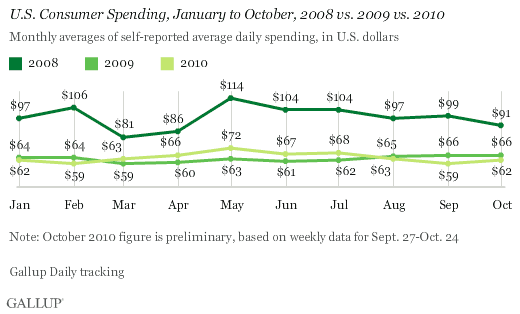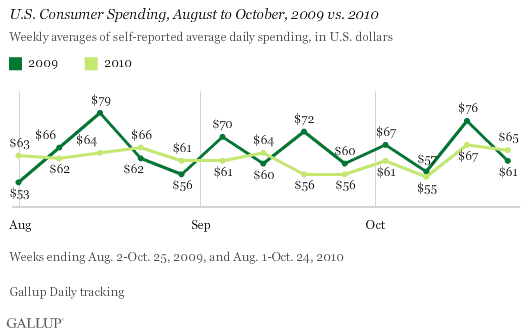PRINCETON, NJ -- Americans' self-reported spending in stores, restaurants, gas stations, and online averaged $62 per day during the first four weeks of October. That figure is up from $59 in September and is about the same as the $63 figure from August. From a broader perspective, spending remains in the 2009-2010 new normal monthly average range of $59 to $72 and is far below the 2008 recessionary spending range of $81 to $114.

Weekly Self-Reported Spending Up From 2010 Lows
Gallup's consumer spending measure over the last two weeks (ending Oct. 17 and Oct. 24) has averaged $67 per day and $65 per day, respectively, slightly higher than the estimate for all of October to date. The increase is likely a result of Halloween shopping, given that in the past, Gallup has seen increases in spending during the second half of October.
The latest weekly figures are also up from late September, which saw some of the lowest spending weeks of 2010. Over the past four weeks, spending has averaged slightly below year-ago levels.

Another Tough Christmas for Retailers
While spending is up slightly in October from September, year-over-year comparisons are not encouraging, with spending remaining in the new normal range established in 2009 and continuing into 2010. In turn, this is consistent with Gallup's October Christmas spending estimate that suggests another anemic holiday season for the nation's retailers.
Continued high unemployment, at 10.0% on a not-seasonally adjusted basis, also suggests another weak Christmas spending season, as Americans who are unemployed or fearing job loss tend to spend less, even around the holidays. Further, the increasing cost of gas and other commodities may limit the ability of many Americans to spend in other areas.
While retailers may be able to encourage consumer buying with aggressive discounting, they will do so at the cost of reducing their margins. At the same time, even as consumers enjoy price discounting, they may experience a reduced selection of goods as retailers try to keep their inventories lean.
There could be better news ahead, perhaps if the Federal Reserve acts next week to promote economic growth and/or if the results of the midterm elections make some consumers feel better. Regardless, until there is an indication of significant change, Gallup's data suggest another anemic holiday sales season ahead.
Gallup.com reports results from these indexes in daily, weekly, and monthly averages and in Gallup.com stories. Complete trend data are always available to view and export in the following charts:
Daily: Employment, Economic Confidence and Job Creation, Consumer Spending
Weekly: Employment, Economic Confidence, Job Creation, Consumer Spending
Read more about Gallup's economic measures.
Survey Methods
Results are based on telephone interviews conducted as part of Gallup Daily tracking with a random sample of 1,000 adults, aged 18 and older, living in all 50 U.S. states and the District of Columbia, selected using random-digit-dial sampling.
For results based on the weekly sample of national adults averaging 3,500 interviews, one can say with 95% confidence that the maximum margin of sampling error is ±2 percentage points.
Interviews are conducted with respondents on landline telephones and cellular phones, with interviews conducted in Spanish for respondents who are primarily Spanish-speaking. Each daily sample includes a minimum quota of 150 cell phone respondents and 850 landline respondents, with additional minimum quotas among landline respondents for gender within region. Landline respondents are chosen at random within each household on the basis of which member had the most recent birthday.
Samples are weighted by gender, age, race, Hispanic ethnicity, education, region, adults in the household, cell phone-only status, cell phone-mostly status, and phone lines. Demographic weighting targets are based on the March 2009 Current Population Survey figures for the aged 18 and older non-institutionalized population living in U.S. telephone households. All reported margins of sampling error include the computed design effects for weighting and sample design.
In addition to sampling error, question wording and practical difficulties in conducting surveys can introduce error or bias into the findings of public opinion polls.
For more details on Gallup's polling methodology, visit www.gallup.com.
